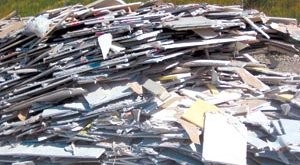The prevention and recycling of clean drywall waste

by Dr. Shouhai Yu,
Having been banned from disposal in landfills in other jurisdictions, 61,100 tons of drywall waste (gypsum) is landfilled annually in Alberta. In March 2007, a project to develop a systematic lifecycle approach for Alberta’s construction industry to reduce the amount of drywall waste generated and landfilled was begun at the Edmonton Waste Management Centre of Excellence (EWMCE). “The Prevention and Recycling of Clean Drywall Waste” project was undertaken at the EWMCE facility and at the University of Alberta (UA), and was completed in February of last year. Specifically, the project encompassed the development of optimization models for pre-construction design software to reduce waste generation, the composting of non-recyclable drywall, and the use of the composted drywall for reclamation of disturbed soils. A Steering Committee was formed for the project from the start, and regular meetings were organized to monitor the progress of the project.
Phase I of the project was carried out by Dr. Mohamed Al-Hussein and a graduate student from the UA’s Faculty of Engineering. The first phase targeted prevention of drywall waste generation by developing optimization models for pre-construction design software. The software provided the automation and generation of construction and shop drawings for the building industry, relying on 3D and parametric modelling techniques, as well as the minimization of construction wood materials through the use of mathematical models, and a search for best combinations on drywall layout. (This software is still in the prototype stage with no commercialization to date – but has been utilized by one residential builder in the Edmonton area.)
Phase II of the Prevention and Recycling of Clean Drywall Waste project, which was carried out with the help of Mr. Richard Johnson from the Alberta Research Council, focused on composting of non-recyclable drywall. Bench scale tests and commercial scale experiments were carried out and mature composts were analyzed and delivered for use in Phase III. Based on subjective observations, it was found that there was no obvious H2S odour from the windrows, either at the EWMCE or at the Edmonton Research Station (located at the University of Alberta). It was also found that the paper on the drywall was completely gone after the six month composting period.
As a composting amendment, phase II showed that drywall greatly reduced nitrogen losses when mixed with dairy manure. Ammonium nitrogen in drywall manure compost was 50 percent higher than that without the addition of drywall, while sulphur content was 10 times higher and calcium was three times higher.
To maximize such beneficial effects however, it was found that composting substrate needs to be well mixed with drywall waste, and a substrate moisture content around 60 percent is desirable. Moreover, if the drywall addition exceeded 30 percent, negative effects might start to dominate. (A drywall composting operation manual was compiled based on the experience gained from this project.)
Phase III of the project was about drywall compost application, and was done by Professor Anne Naeth and associates, Department of Renewable Resources, Faculty of Agriculture, Foods and Nutritional Science, University of Alberta. Phase III was focused on assessing the use of compost amended with drywall. The research showed that compost improved tailings sand as a medium for plant establishment and growth for each of the plant species tested. It was also found that the addition of composts to agricultural or urban soils was of little benefit to the germination of Agropyron trachycaulum (Slender Wheatgrass) and Hordeum vulgare (an annual grass from which barley is derived) or to final plant densities. And the same composts applied to these soils had a somewhat phytotoxic effect on Festuca saximontana (Mountain Fescue) germination, plant density and biomass. Compost addition to agricultural soil did however increase Agropyron trachycaulum’s below ground biomass, and when applied to clean fill above-ground, biomass was enhanced.
Phase III showed that manure composts had the highest pH and electrical conductivity values, and that native species were less tolerant of them than Hordeum vulgare. In general, it was found that the addition of drywall to manure compost did not benefit plant response. The addition of drywall however did considerably increase the calcium, sulphur and boron content of the compost, which was not a benefit to plants based on the parameters measured. The effect of the addition of drywall to biosolids compost was dependent on soil type, species and parameter measured.
The Prevention and Recycling of Clean Drywall Waste project received considerable attention when preliminary results were presented at several workshops. Questions were raised regarding different aspects of the project, demanding further information before practical implementation of a similar project. Based on the results and feedback, recommendations were made at the end of the report for future development.
Dr. Shouhai Yu is a postdoc fellow working at the University of Alberta.

